Photographing very dark animal.
Apr 28, 2020 09:05:37 #
I have a very dark dog. I am looking for suggestions for the best way to photograph him without using a flash. His coat is very black and it is hard to get any definition of his features. Any suggestions are appreciated.
Apr 28, 2020 09:09:12 #
Apr 28, 2020 09:19:23 #
rmg49 wrote:
I have a very dark dog. I am looking for suggestions for the best way to photograph him without using a flash. His coat is very black and it is hard to get any definition of his features. Any suggestions are appreciated.
Your cameras meter will overexposed a dark subject trying to achieve 18% gray. Turn your exposure compensation dial to -1 or even a bit more to get proper exposure.
Apr 28, 2020 09:28:59 #
petercbrandt
Loc: New York City, Manhattan
MT Shooter wrote:
Your cameras meter will overexposed a dark subject trying to achieve 18% gray. Turn your exposure compensation dial to -1 or even a bit more to get proper exposure.
Exactly, best advise, even for a night /evening photo. Key thing to remember the meter tries for getting that medium grey. Even snow or a sunny beach you must increase (over expose) by 1-1.5 stops. Don't let the meter through you off.
Apr 28, 2020 11:03:37 #
Apr 28, 2020 11:30:58 #
Apr 28, 2020 14:26:32 #
I have photographed BLACK dogs with coats that seem to EAT LIGHT! My most difficult one was a big-100 lb., shaggy Bouvier des Flandres- so dark, it was hard to find his eyes! You might need to expose for the "shadows which would entail overexposing by 1 or 2 stops. If you can only use natural light, you can take the dog out of doors in the late afternoon and allow the backlight to skim across the coat, providing texture) and fill in with a "silver" reflector. If you don't have a reflector, make one out of crushed and re-expanded aluminum foil adhered to a 20x20 sheet of Foam-Cor or similar material.
Hopefully, your pet is not wildlife, so you can make some test exposures and find which is the best one to render texture and detail in the coat.
I'll try to locate the file of that dog- Meanwhile- "Molly" here- is black as coal except for her white patch. The backlight coming through the window provided texture. 1-stop overexposure brought up the shadow detail. Fill was a foil-covered cardboard cake base for the $1. store.
To retain detail, you jet black may record slightly more gray and you may blow our the highlights in the background. In my studio or out of doors with flash fill, I can better control and condense the range.
Hopefully, your pet is not wildlife, so you can make some test exposures and find which is the best one to render texture and detail in the coat.
I'll try to locate the file of that dog- Meanwhile- "Molly" here- is black as coal except for her white patch. The backlight coming through the window provided texture. 1-stop overexposure brought up the shadow detail. Fill was a foil-covered cardboard cake base for the $1. store.
To retain detail, you jet black may record slightly more gray and you may blow our the highlights in the background. In my studio or out of doors with flash fill, I can better control and condense the range.
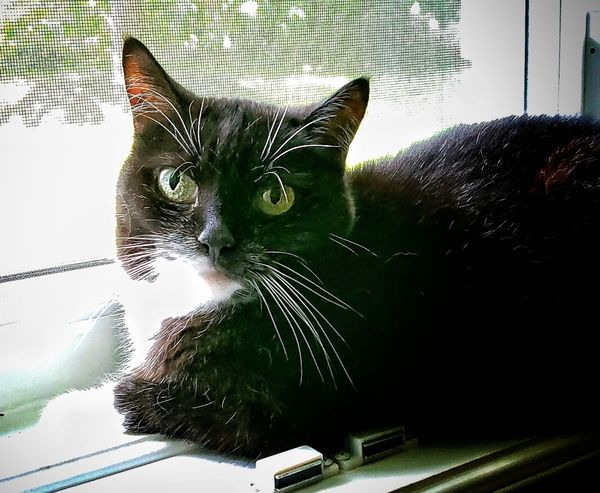
Apr 28, 2020 14:29:03 #
MT Shooter wrote:
Your cameras meter will overexposed a dark subject trying to achieve 18% gray. Turn your exposure compensation dial to -1 or even a bit more to get proper exposure.
Right idea, wrong direction. Set to +1 or 2. Works in all BUT A Mode.
Apr 28, 2020 14:41:17 #
rmg49 wrote:
I have a very dark dog. I am looking for suggestions for the best way to photograph him without using a flash. His coat is very black and it is hard to get any definition of his features. Any suggestions are appreciated.
If you were shooting negative film, I'd suggest you measure you dog's dark fur and set your camera to expose up to 2 stops lower, which would ensure enough shadow detail would be captured in the negative.
But with digital, you can, and should expose higher. If you shoot raw. there is nothing wrong with using the camera's spot meter to measure the fur, and setting the camera to the reading - it will result in a gray dog, but it is more than easy enough to adjust the brightness of the shadow areas lower.
You will need to have some control over the light. It will define his features and contours. Bounced flash is ideal, a large softbox is a second great choice, since any direct, unmodified flash will really reflect off the shine in the coat and provide unnecessarily high contrast. You want the light to be directional (from the side) and big and soft whenever possible.
I set the camera to manual exposure, metering to spot, and adjust as necessary to get a good exposure, ie one where important highlights are not blown. This is obviously more important when you have an animal with both white and black in their coat or shot together with another subject (last image).
.
35 watt porch light - ISO 6400, 1/15, F2.8
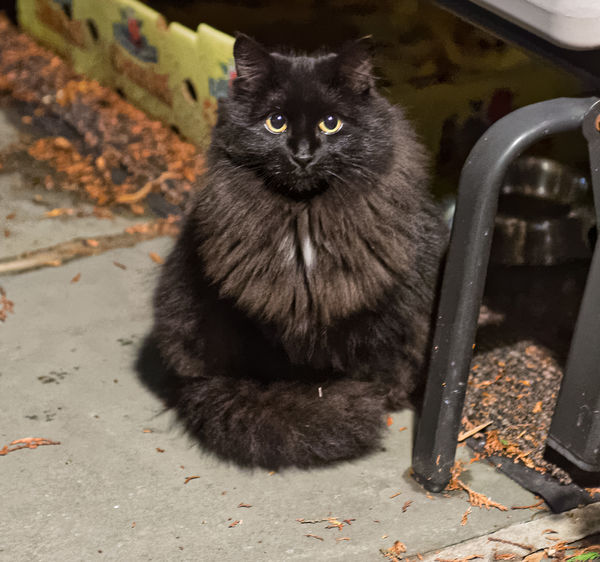
(Download)
bounced flash (behind me), F5.6, ISO 200.
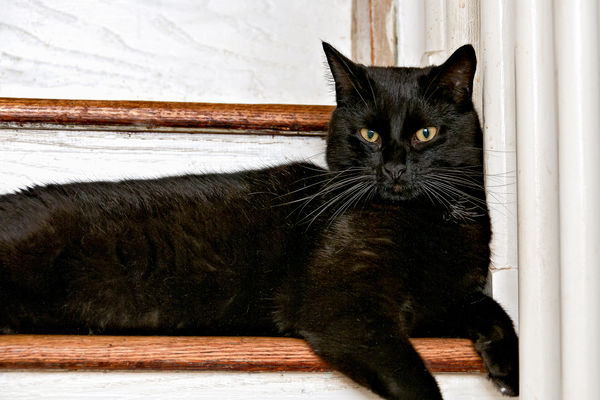
(Download)
light filtered through window - 1/200, F7.1 SO 400.
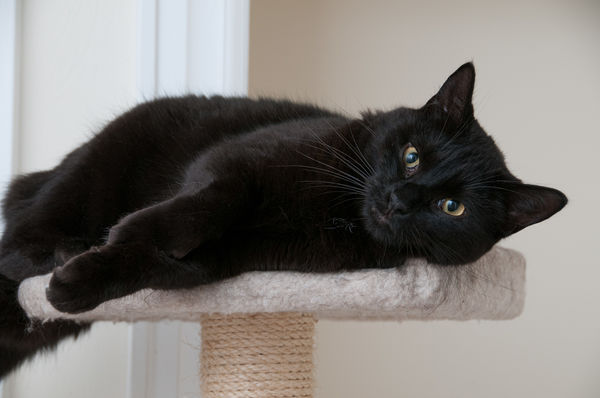
(Download)
Bounce flash, 1/50, F5.6, ISO 400.
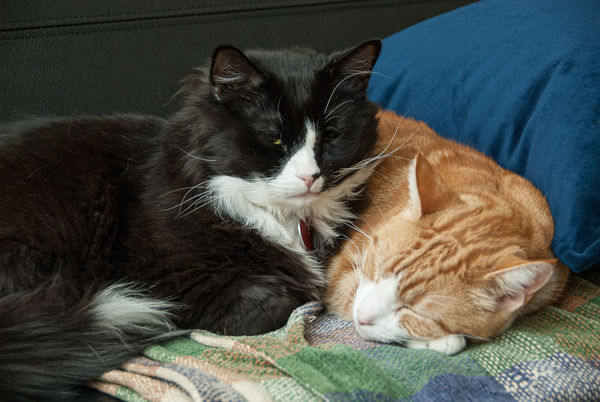
(Download)
Apr 28, 2020 15:03:55 #
rb61
Loc: Maple Grove, MN
PHRubin wrote:
Right idea, wrong direction. Set to +1 or 2. Works in all BUT A Mode.
Everyone seems to agree that a cameras meter will overexpose a dark object as it tries to reach middle gray.
Why would someone increase exposure (+1-+2) to make it look lighter. +1 or +2 is for underexposed light objects.
If you spot meter a white object and a black object, both will be approximately the same tone of gray.
Apr 28, 2020 15:15:01 #
To emphasise a point already made, try to NOT include any bright objects, lights or windows in the frame with the dog. You'll want to keep the exposure high and any highlights will be susceptible to being blown
Apr 28, 2020 15:21:05 #
rb61 wrote:
Everyone seems to agree that a cameras meter will overexpose a dark object as it tries to reach middle gray.
Why would someone increase exposure (+1-+2) to make it look lighter. +1 or +2 is for underexposed light objects.
If you spot meter a white object and a black object, both will be approximately the same tone of gray.
Why would someone increase exposure (+1-+2) to make it look lighter. +1 or +2 is for underexposed light objects.
If you spot meter a white object and a black object, both will be approximately the same tone of gray.
Good question. Many photographers depend on their in-camera metering system and learn how to override it in order to compensate for certain lighting or range issues. In my own case, I prefer to decide on whether I am going to spot meter for highlight, middle tones or shadows "expose to the right". etc., and make whatever adjustments are required in post-processing as part of a predetermined plan or method. This precludes what the "camera wants to do or thinks" in terms of 18% gray. Some photographers may have not as yet discovered and learned exactly how to utilize all the metering options in their camera- spot, matrix, average, integrated, etc.
Perhaps some folks are confusing the function of an incident light readings with a handheld meter whereby the meter is interpreting everything in terms of 18% and you end up with gray snow or blacks void of detail in some circumstances.
Apr 29, 2020 01:56:02 #
Gene51 wrote:
If you were shooting negative film, I'd suggest yo... (show quote)
Great examples those indeed are the “proof of the pudding”. Beautiful cats. Yours?
Apr 29, 2020 06:26:31 #
rmg49 wrote:
I have a very dark dog. I am looking for suggestions for the best way to photograph him without using a flash. His coat is very black and it is hard to get any definition of his features. Any suggestions are appreciated.
Provided his coat is not too smooth - wait for a nice bright day, back brush his coat to lift it and shoot on any auto mode. There should be no need to compensate exposure if the sun is on him. Here is my wonderful boy, now waiting for me above. The photo taken as I have recommended.

Apr 29, 2020 06:35:41 #
If you want to reply, then register here. Registration is free and your account is created instantly, so you can post right away.









